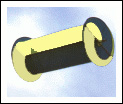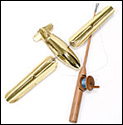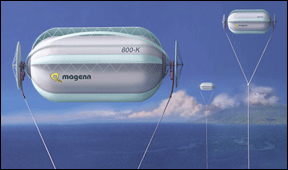Kites Adorn Ahmedabad Skies With Colour For Four Day Uttarayan Festival
From January 14-18 2006 the skies above the city of Ahmedabad, in the state of Gujarat, will be filled with darting flecks of colour. Tens of thousands of kites take to the sky in the festival of Uttarayan.
 Scores of kite flyers from India and about 65 invited guest flyers from abroad, including Denmark, the Netherlands, Germany, France, Spain, Italy, Canada, China, Japan, Lebanon, Indonesia, the Philippines, Sri Lanka, Israel, Malaysia, Belgium and Australia, are participating in a special flying event in Ahmedabad.
Scores of kite flyers from India and about 65 invited guest flyers from abroad, including Denmark, the Netherlands, Germany, France, Spain, Italy, Canada, China, Japan, Lebanon, Indonesia, the Philippines, Sri Lanka, Israel, Malaysia, Belgium and Australia, are participating in a special flying event in Ahmedabad.
Regarded as the largest kite festival in the world, the event sprawls across the city of Ahmedabad as thousands of local kite fliers take to rooftops to engage in battle with one another for supremacy of a section of sky.
The Times of India quotes visiting Israeli kiter Ralph Resnik as saying: "Ahmedabad is the heart and the home of fighter kiting. It is something you have to experience. It looks like a ticker-tape parade on the streets of New York except, all the confetti is suspended."
Another festival in Jaipur, state of Rajasthan, will feature flying on the palace grounds in Jaipur under the watchful eye of Jaipur's royal family.
Kite flyers take to the rooftops, streets, vacant lots, and railway tracks - anywhere that there is an open space to permit kiters to raise their kites and engage in battle. This can be dangerous as the flyer is usually looking skyward and does not always attend to the edge of the rooftop or the traffic conditions in the street. Newspapers run daily notices advising people to avoid power lines with their kites and strings, yet stories of young fliers receiving burns while removing kites from power lines are frequent.
One unusual aspect of the festival is betting on kite battles. So called professional kite fliers have followings of people who wager on their kite fighting prowess. The 'Kanpur Times' section of The Times of India reports:
"While kite flying clubs in the city organise competitions round the year, it's specially at festival time that most members participate in the competitions, thanks to the large scale betting involved. Most of the professional kite flyers gather in big grounds during the festive period and heavy amounts of money are on stake," informs businessman and a professional kite flyer Abhishek Mehra. Even amateur kite flyers are attracted to these kite flying competitions or kite fights, as they are called, because of the lure of big bucks. "Getting involved in kite fights is interesting for me not because I'm good at it but because I'm hoping to multiply my money this way," says Manish Agarwal, a dry fruit merchant.
 In addition to being a major festival and holiday, the event puts a good deal of money into the hands of kite builders during this intense period of kite flying. Not only are skilled kite artisans plying their kites in shops all around the region, but large numbers of children and teenagers work alongside adult kite makers to manufacture millions of kite strings ahead of this kite-flying festival. The youngsters earn about one dollar for a twelve hour work day. In addition to local youth about 300 young people from neighbouring provinces trek to Ahmedabad to engage in this work and make some much needed money for their families.
In addition to being a major festival and holiday, the event puts a good deal of money into the hands of kite builders during this intense period of kite flying. Not only are skilled kite artisans plying their kites in shops all around the region, but large numbers of children and teenagers work alongside adult kite makers to manufacture millions of kite strings ahead of this kite-flying festival. The youngsters earn about one dollar for a twelve hour work day. In addition to local youth about 300 young people from neighbouring provinces trek to Ahmedabad to engage in this work and make some much needed money for their families.
While most kite sales are to individual kite fliers, this year there is a trend toward bulk orders of "corporate kites" that advertise the products of various companies or services in India. Corporate clients place large bulk orders for kites imprinted with logos or product photos and then give them away as sales promotions. This has added significant cash flow to some of the larger kite making firms that specialize in Indian kites for both the export and local markets.
Globalization has also come to the Indian kite market. Chinese kites made of plastic have been introduced this year to compete with the beautifully crafted paper kites of India. These kites are generally more expensive than the Indian made kites. In addition, they are of the "single line" stable kite variety and fly in a more or less static manner. Traditional Indian kites are made to be highly maneuverable at fast speeds and are well suited to the traditional kite battles that take place in the skies above the towns and cities.
More details can be found in the following stories from Indian news media:
- Gujarat's Kite Fest Gets Underway - The Hindu News Update Service
- Flying Kites the Royal Way - IBN Live
- Twin Cities in Grip of Festival Fever - The Times of India
- Gujarat's Spectacular Kite Festival Gets Underway - NewKerala.com
- Child Labourers Gear Up for Rahasthan's Kite Festival - The Hindustan Times
- All Set for the Sky Battle in Ahmedabad - The Times of India
- Kite Fliers Risk Life for Sport - Ludhiana Newsline
- Kitemakers Fly High on Whopping Sales - Mid-Day.com
- Boy Suffers Burns While Removing Kite from High-Tension Wires - The Hindu: Andhra Pradesh
- Higher Stakes on High Flyers - Kanpur Times Section of The Times of India
Research Note:
- Special thanks to Vaino Raun of the Niagara Windriders Kitefliers Association for information relating to this article. Vaino is a much travelled, skilled and knowledgeable kite builder and flyer who readily shares his knowledge and insights with any who ask. Thanks, Vaino!
- KiteLines Magazine - Volume 7, Number 3, Summer 1989. Articles on "India's Annual Kite Fenzy".
- "Kites Over Ahmedabad" - Article and Illustrations by George Peters. Pages 42-45.
- "Kites of Makar Sankranti" - Article by Philip Morrison, photographs by Setu and Parthiv Shah. Pages 46-49.
Uttarayn Celebration in Clarksville, Tenn. U.S.A.:
Clarksville, Tennessee held a kite festival on Saturday, January 14, 2006 to celebrate the Indian festival of Uttarayan. The Leaf-Chronicle newspaper of Clarksville reports:
"Bright blue skies over Fairgrounds Park were filled Saturday with a colorful Indian tradition.
About 150 members of the Clarksville-Hopkinsville, Ky., community of Indians gathered to observe Uttarayan — a predominantly Hindu-celebrated kite festival held for thousands of years to mark the decline of winter and the promise of spring."
This was the first time that Uttarayan had been celebrated in Clarksville and it clearly was a representation of the blending of two cultures for the participants:
"Event organizers for Saturday's celebration imported about 600 kites and 20 rolls of kite string, which is coated with a special glue made from glass powder and rice paste.
Saturday's celebration featured a meal of traditional Gujaratian cuisine.
As Mayur Mehta watched the kites frolicking in the steady breeze, he smiled when he noticed the backdrop — a subtle reminder of two cultures entwined.
"There's an American flag, right there in front of us," he said."
For the full story and photos visit the article by reporter Heather Donahoe in The Leaf-Chronicle newspaper.
Rotor Kites Move From Toy Novelty to High Tech Power Generation
 The horizontal rotor kite is a very unusual kite. When seen in the skies at a kite festival it often provokes many comments from spectators. The horizontal rotor kite has been around for quite some time although its exact date of origin or verified inventor have not been determined. Rotor kites are usually quite small when compared to other kites found in the skies. Indeed, the rotor kite seems so much like a child's toy that the vast majority of serious kite hobbyists do not even own one.
The horizontal rotor kite is a very unusual kite. When seen in the skies at a kite festival it often provokes many comments from spectators. The horizontal rotor kite has been around for quite some time although its exact date of origin or verified inventor have not been determined. Rotor kites are usually quite small when compared to other kites found in the skies. Indeed, the rotor kite seems so much like a child's toy that the vast majority of serious kite hobbyists do not even own one.
The horizontal rotor kite achieves flight through a little known scientific principle, the 'Magnus effect'. Kite flyers are generally very knowledgeable about the principles of lift and the Bernoulli effect, but often are not as aware of the Magnus effect and how it provides lift to a horizontally spinning object.
Plans to build an original horizontal rotor kite can be taken from a patent drawing or from Anthony's Kite Site, one of the better kite plan web sites on the Internet. Using either balsa wood or styrofoam meat trays, a rotor kite can be constructed in reasonable time. It will certainly gather attention at most kite festivals since they are not typically seen in the sky.
 Likely, the most famous incarnation of the rotor kite is the "Skyroplane" toy which was first marketed in the early 1950's. Sporting two rotating wings, the Skyroplane came in a boxed set complete with a wooden flying reel and flying line. My Skyroplane is still in its original box and is lovingly cared for although it is fifty years old and has enjoyed many hours of flight time. The Skyroplane is still available today and can be reasonably purchased through a number of on-line sources including Jensen Scientific.
Likely, the most famous incarnation of the rotor kite is the "Skyroplane" toy which was first marketed in the early 1950's. Sporting two rotating wings, the Skyroplane came in a boxed set complete with a wooden flying reel and flying line. My Skyroplane is still in its original box and is lovingly cared for although it is fifty years old and has enjoyed many hours of flight time. The Skyroplane is still available today and can be reasonably purchased through a number of on-line sources including Jensen Scientific.
Recently, however, the horizontal rotor kite has become a major news maker. A Canadian firm, Magenn Power Inc. of Kanata, ON, a suburb of Ottawa, announced in November 2005 that they will use tethered kite like devices in an innovative application of technology to create electrical energy.
I first came across this as a news story in the Thursday, December 29, 2005 issue of The Toronto Star newspaper (hard copy version - Section D: Business (pages D-1 and D-10). The article is quite lengthy and features some interesting diagrams provided by Magenn Inc.
The company's web site states:
"The Magenn Power Air Rotor System (MARS) is an innovative lighter-than-air tethered device that rotates about a horizontal axis in response to wind, efficiently generating clean renewable electrical energy at a lower cost than all competing systems. This electrical energy is transferred down the tether to a transformer at a ground station and then transferred to the electricity power grid. Helium (an inert non-reactive lighter than air gas) sustains the Air Rotor which ascends to an altitude for best winds and its rotation also causes the Magnus effect. This provides additional lift, keeps the device stabilized, keeps it positioned within a very controlled and restricted location, and causes it to pull up overhead rather than drift downwind on its tether."
The essential difference between a true rotor kite of the variety known to kite builders and the Magenn MARS device is the fact that the horizontal rotor chamber is filled with lighter than air gas to aid in lift. The rotation of the horizontal rotor will provide some additional lift and generate power in the traditional manner of a spinning generator.
 Wow - the simple rotor kite goes very high tech!
Wow - the simple rotor kite goes very high tech!
Magenn states that a one kilowatt portable generator rotor will be available first and could be used to power camp sites in remote locations. Larger four kw rotor generators could be used to power cottages or in disaster recovery locations. Even larger 60 metre long rotor units could generate 1.6 megawatts of power to meet the needs of thirty typical homes. Gathered together into an energy kite farm, even larger amounts of power could be generated, according to the company.
This is a story that deserves some watching as events continue to develop.
__________________________________
Notes:
- The Magnus effect was fully explained by physicist G. Magnus in 1852. "On the derivation of projectiles; and on a remarkable phenomenon of rotating bodies." G. Magnus, Memoirs of the Royal Academy, Berlin(1852). English translation in Scientific Memoirs, London (1853)., p. 210. Edited by John Tyndall and William Francis.
- Depending on the orientation of the axis of a rotating cylinder (horizontal or vertical) the Magnus effect will either provide lift (horizontal spin dirention) or forward motion (vertical spin direction).
- A detailed explanation of the Magnus effect can be found at: the Magnus Effect page -and- NASA's web page on the Lift of a Rotating Cylinder.
- While not specifically related to kites, the application of the Magnus effect by German scientist Anton Flettner in 1926 to move a ship with a vertical rotating columnar 'sail' is one of the most unusual applications of the Magnus principle. Use of the Magnus effect to power a ship was revived by Jacques Cousteau in 1985 with his famous "Alcyone". Both are interesting topics for additional reading.
Night Kites Arrive on Indian Kiting Scene
North American kite festivals have increasingly featured "Night Flies" as part of their festival schedule for the past ten years. Some spectacular events have occurred when ideal wind conditions and dramatic lighting effects were combined to illuminate kites in the sky. Some kites bear battery powered lights while others rely on spotlights from the ground to show them off. The use of reflective mylar sails and special reflective tapes have added to the effect in the night sky.
Now it appears that the "night kites" have come to India as well. Today's Ahmedabad Newsline features the following story of battery powered lights on kites emerging in India for this year's kite festival season.
With this kite, get set and glow
Patangwala has designed unconventional kite: it has battery-operated bulbs
Express News Service - Ahmedabad, January 5:"THIS kite will sure light up the sky during this Uttrayan. Call it technological advancement or innovation born out of sheer need!
Having left with no time to fly kite during the day, a kite-maker in the Jamalpur area of Ahmedabad found a novel way to enjoy kite flying in the night — the only time he is left with after selling kites through the day during Uttrayan.
Pappu Patangwala has transformed a conventional kite by attaching tiny square bulbs in different colours of blue, red and green to it. These bulbs operate on batteries attached to them with the help of switch.
In the business for some years now, Patangwala said, ‘‘It’s only during the night that we get a chance to actually fly kite, as we are busy selling kites till late in the evening. Since, it is very difficult to locate kite in the dark, the idea of attaching bulbs to it struck me.’’
Flying kites in the night would now be easier. This innovation would give a new meaning to kite flying, especially for those who like to fly kites during night time and also for those who fear sun tan. The battery attached to individual bulbs will last for maximum five hours and a kite can hold a maximum of six such bulbs.
‘‘The bulbs can be pasted on the surface of the kite with the help of glue,’’ he added.
Patangwala has used two batteries (button cells) and a condenser to light the bulbs. ‘‘I have not used wires. There’s a switch attached to them which gives the kite-flyer option to switch it on and off.’’
But would the kite be able to fly owing to the weight of the bulbs? ‘‘They can easily fly when its windy,’’ said Patangwala
But the innovation comes at a price.
A single kite costs around Rs 20 while there are some discounts for those who want it in bulk. ‘‘At present, the rate is quite high since it is just the beginning of the season. I am working on reducing the cost of manufacturing so as to reduce its cost,’’ he said. "
Kites Big Business During Makar Sankranti
Kites are big business during Makar Sankranti. Since kite flying and fighting is such a well established tradition within the culture of India, this period of the year sees large sales of kites annually. The interesting fact is that sales tend to grow each year by ten to twenty per cent over the previous year.
While most of the kites made and sold during the holiday have been created in India, over the past two years there has been a trend towards imported kites from China made of non-traditional materials such as mylar and plastc. In addition to the new materials, new shapes and new designs are emerging in these imported kites. However, the traditional well made Indian fighter kite constructed of bamboo and tissue paper dominates both the skies and the sales.

Kite flying is Serious Business on Makar SankrantiFrom: newKerala.com - Jan. 1, 2006
Shah Rukh Khan, Aishwarya Rai and Amitabh Bachchan sashaying in the clouds, Congress president Sonia Gandhi's airborne clashes with senior Bharatiya Janata Party (BJP) leader Atal Bihari Vajpayee and Railway Minister Lalu Prasad's aerial dance will be a novel draw for kite enthusiasts.
Khan said Chinese kites too had arrived in the market. Though they were more attractive in shape and design, they were yet to gain popularity as the paper used to make them was of inferior quality.
Khan said the prices of kites ranged from 25 paise to Rs.25 and Jaipur alone accounted for up to Rs.650 million ($14.46 million) of business annually.
The kite trade is a round-the-year business in Rajasthan and people from various districts and states fly kites on several occasions, according to tradition, said Iqbal.
Iqbal expected business to be brisk this season, as the demand for kites was already high. "The interest in flying kites has not waned over the years as demand has been increasing by 20 percent every year," he said.
New style kites for Makar Sankranti will feature human-shaped kites with photographs of celebrities and politicians. The kites are all Indian made, reports the Mumbai Mirror in a special article about kites available during the 2006 Maksr Sankranti festival. A photo of the new style kites is also available on line.
Makar Sankranti - Indian Festival Begins January 14, 2006
Kite flying in India is a major cultural activity. Traditionally it is boys and men that fly kites in India. The festival of Makar Sankranti, heralding the beginning of Spring, is the major kite event of the year.
Makar Sankrati celebrates the northward journey of the sun as it enters a new zodiac which coincides with the beginning of longer days of sunlight. The excitement of the coming of spring is celebrated in a number of ways: with food, family gatherings, street fairs, music and kite flying. As the winds change to herald the advance north of the sun, the winter sky bursts into colour with thousands of paper kites
Unlike kite festivals in North America and Europe which last anywhere from one to five days in one particular festival site or location, the kite flying in India that is associated with Makar Sankranti goes on in all towns and cities for several weeks.
A terrific background article on Makar Sankrati can be found on the Surf India travel website where the importance and origins of the festival are outlined. In addition, this site describes some of the regional differences of the celebration in major cities of India.
A magnificent slide show, entitled Flying Colours, about the kite flying during Makar Sankranti is found on the Rediff.com travel web site. The slide show is a must for kiters interested in understanding the role of kites in the culture of Indian. The marvelous photos capture the types of kites, significance and excitement of kite flying, the economic aspects of kites (building and selling) and the magic of the kite battles that occur at the end of each day from the roof tops of the cities.
For kiters interested in reading a wonderful account of the amazing kite flying from the roof tops of buildings in Ahmebad, you are referred to Kitelines, The Quarterly Journal of the Worldwide Kite Community: Summer 1989 Vol. 7, No. 3. In this journal are two excellent articles:
- "Kites Over Ahmedabad" - article and illustrations by George Peters (pages 42-45)
- "Kites of Makar Sankranti" - article by Philip Morrison and Photographs by Setu and Parthiv Shah (pages 46-49).
George Peters' amazing illustrations from the first article above capture the intensity and scope of the festival.
In the coming weeks there will be more postings aboout this amazing kite flying period in India.





